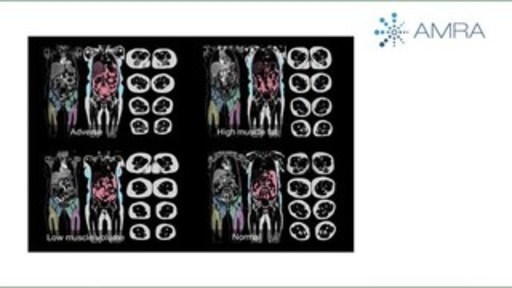LINKÖPING, Sweden, Oct. 28, 2020 /PRNewswire/ -- AMRA's research, in collaboration with Linköping University, proposes a standardized muscle-specific metric using magnetic resonance imaging (MRI) to detect a vulnerable muscle phenotype within non-alcoholic fatty liver disease (NAFLD) and recommends strengthening of future sarcopenia guidelines by the introduction of cut-off values for muscle fat. This research is accepted for publication in JHEP Reports.
The research included 9,545 UK Biobank participants. Liver fat, fat-free muscle volume (FFMV), and muscle fat infiltration (MFI) were quantified using a rapid MRI protocol and automated image analysis. The researchers then assigned each participant a personalized FFMV z-score, calculated using virtual control groups (VCGs)1, which was combined with MFI to detect adverse muscle composition (AMC). Functional performance was assessed using hand grip strength, walking pace, stair climbing, and number of falls. Metabolic comorbidity was based on the presence of coronary heart disease and type 2 diabetes.
AMRA's research revealed 14% of patients with NAFLD displayed AMC and experienced a very high prevalence of metabolic comorbidities (2.1 – 3.3 times) and increased prevalence of poor function (1.7 – 2.4 times) compared to those without AMC. When comparing patients with NAFLD to those without fatty liver, the prevalence of poor function and metabolic comorbidity were similar or higher. In contrast, the prevalence of sarcopenia was significantly lower – stressing limitations with the current sarcopenia definition. This research suggested that AMC is a highly vulnerable and common phenotype in NAFLD and muscle fat infiltration thresholds could strengthen sarcopenia guidelines.
The researchers found that objectively measuring muscle health, specific to the individual, by assessing MFI and FFMV (utilizing VCGs) using MRI could help identify highly vulnerable patients and enable early prevention of severe liver disease in future research studies.
Mattias Ekstedt, Senior Lecturer at Linköping University said "To monitor sarcopenia in the clinic is a challenge. This study gives us hope of a more precise diagnostic of this important clinical entity."
AMRA expects to continue to release more results on how the growing societal burden of sarcopenia effects specific population groups in order to support strengthening the guidelines for sarcopenia.
Read the full publication at JHEP Reports. Learn more about AMRA's methods at amramedical.com
About UK Biobank
UK Biobank is a leading research institution which collects and curates a large and unique biomedical database that can be accessed globally by scientific researchers, with the explicit goal of improving public health.
Since 2006, UK Biobank has collected and processed an unprecedented amount of biological and medical data on half a million people, aged between 40 and 69 years old and living in the UK, as part of a large-scale prospective study. They have provided blood, urine and saliva samples, as well as detailed information about themselves and agreed to have their health followed. This de-identified data – the largest and richest dataset of its kind – have since been made openly accessible by UK Biobank to researchers around the world who use it to make new discoveries about common and life-threatening diseases – such as cancer, heart disease and stroke – in order to improve public health.
About Linköping University
Linköping University, LiU, conducts world-leading, boundarycrossing research in fields that include materials science, IT and hearing. In the same spirit, the university offers many innovative educational programmes, frequently with a clear professional focus and leading to qualification as, for example, doctors, teachers, economists and engineers. LiU was granted university status in 1975 and today has 32,000 students and 4,000 employees. The students are among the most desirable in the labour market and international rankings consistently place LiU as a leading global university.
About AMRA Medical
AMRA is a ground-breaking international digital health company at the forefront of medical imaging and precision medicine. The company has developed a new global standard in body composition assessment, the ability to automatically produce multiple fat and muscle biomarkers with unrivaled precision and accuracy, as well as contextual disease insights – all from a single, rapid, whole-body MRI.
1Linge et al, J Gerontol A Biol Sci Med Sci 2020. doi: 10.1093/gerona/glz229
SOURCE AMRA Medical
Related Links
WANT YOUR COMPANY'S NEWS FEATURED ON PRNEWSWIRE.COM?
Newsrooms &
Influencers
Digital Media
Outlets
Journalists
Opted In

Share this article